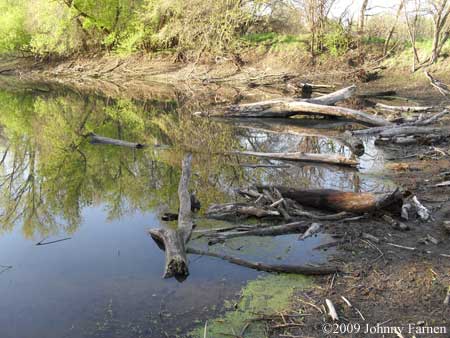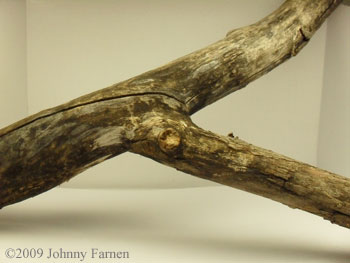Wood for Use in Vivaria
By Johnny O. Farnen
The basics
Many people want to use real wood in their enclosures. It is important to note that some types of wood can have detrimental effects on live animals, especially amphibians. There are a few procedures and rules that should be followed prior to introducing wood, found or purchased, to an enclosure. Wood can harbor fungi, insects, bacteria, and even contain toxic substances that can wreak havoc on a new or established vivarium. Without proper research, sterilization, and quarantine, it can be very easy to introduce harmful pests or chemicals that could harm your animals.
Do your research
Identify the source of the wood. Identify the species it came from. Never use wood from commercial orchards or other areas that may have been exposed to pesticides or herbicides. Manufactured wood products like pressure treated lumber or plywood should be avoided at all costs! They contain chemicals that can be fatal to amphibians, like chromated copper arsenate and alkaline copper quat.
The number one rule of wood use is "When in doubt, leave it out." It is always better to be safe than sorry.

While tempting to use, this wood is unsuitable, as the pond is very close to commercial farming fields.
Sterilize
The easiest and safest way to do so is boiling. It is wisest to soak the wood in untreated tap water until it is thoroughly water logged. Change the water often, as soon as it is discolored by the wood. This will help ensure the sterilizing effects of heat will transfer thermally through out the piece and help to remove water discoloring tannins. Choose an aluminum or preferable stainless steel pot to cook with. It is best to purchase a pot from a thrift store to use only for this purpose.
Found wood should be boiled until it is fully waterlogged and sinks to the bottom of the pot. A minimum of 6 hours in a continuous boil should be utilized. You will have to watch the water level and add water as needed. Care should be taken to avoid scalds and burns. It is highly recommended to do this process outdoors where a garden hose or fire extinguisher is available in the event of a fire. Non-stick pots are only safe to use on stoves. Never use non-stick cookware on an open fire or grill. If you must boil wood indoors, keep in mind the rules are the same, but this will cause an odor that people may find offensive.
With purchased wood from pet shops, often times boiling is not necessary. Do not boil purchased wood that has been sealed with epoxy resin. Composite wood products specially made for pet enclosures do not need boiling either, however a good cleaning with hot tap water is recommended.
In the case of purchased wood that has already been submerged in an aquarium, the same techniques applied to live plants should be used for sterilization. A high pH solution of alum or quicklime will kill any hydra, snails, and most worms that may hitch a ride on such pieces.
If you desire to use dead bamboo, it is necessary to pierce each of the inner chambers to prevent possible explosion. At each knuckle of the bamboo is a thick separating membrane, simply pierce these with a long bit of wire coat hanger sharpened on one end.
Drying wood for terrestrial use
This can be done safely in a standard oven set no higher than 200°F (93°C). Drying time varies greatly depending on the density and size of the wood. Plan on at least a few hours, likely more. This will help prevent the growth of mold and fungi. Wood drying in an oven must be supervised closely to prevent fire.
 Cork bark used as an island for caudate juveniles. |
 This purchased mopani wood is sold specifically for aquarium use. Do not use sealed mopani wood, which is intended for dry reptile setups only. |
Woods that should be avoided
These types all contain harmful or potentially harmful substances and should be avoided for use with caudates.
|
|
|
| *See additional information below about safe usage of these wood types. | ||
Many of these wood sources are fruit woods. Some fruit woods have varying degrees of toxicity; however, all should be avoided as the risk of pesticide contamination is very high.
Conifers and evergreens should be used with caution. High concentrations of phenols and turpenines like plicatic acid, abietic acid and taxol present in these woods naturally can cause many detrimental health effects over time, including death. While boiling and heat treating can greatly reduce these toxins, even a small amount left behind can result in respiratory and skin issues. European cypress, red cedar, and most pines in particular should be avoided.
Exceptions to this are products manufactured from the Bald Cypress, Taxodium distichum, which are perfectly safe to use. Substrate products manufactured from fir tree bark are also safe to use. Both are often heat treated by the manufacturer, yet a standard cycle of soaking and drying is suggested prior to use. While commercial fir bark products are safe to use, the actual wood of fir trees should still be avoided.
In the case of the three most highly argued woods, Apple, Cherry, and Eucalyptus, common sense and logic can prevent disasters here. Apple and Cherry are often exposed to pesticides throughout their growing life. This alone should be enough to discourage their use. The actual toxicity of these fruitwoods is debatable. However when in doubt, leave it out.
Eucalyptus is an entirely different story. While there are 746 recognized species of these plants, not all of them are toxic. However identification can be very tough. Since quite a few of them are used to manufacture pesticides, they should all be avoided.
 Boiled, debarked wood collected after a wind storm, dried and ready to use. |
 Prepared wood used in a terrarium. Notice the moss is beginning to grow on the branch! |
Woods that are safe to use
Safe in dry and wet setups: |
Safe only in dry setups: |
|
|
When using purchased wood, make sure it is designed for aquarium use, rather than reptile use. Wood processed for reptiles is often types that you do not want to use in a wet environment. If you decide to use your own found driftwood, avoid ocean driftwood. You will be unable to get rid of all the salt! Driftwood from lakes, rivers and streams in agricultural areas should also be avoided; they are often saturated with pesticides and herbicides. When collecting wood for your vivaria, make sure you are in compliance with local laws. Some US states, and many countries require permits to collect wood.
An ideal source of wood is after a heavy storm. Often, if you check with your friends and neighbors, they are more than happy to let you have wood for free, although you may need to help out in cleaning up all the deadfall. A good hand saw and a chainsaw can be very useful in these situations. Suitable wood that is still green should be allowed to season for at least six months in the manner of firewood. Never cut from live trees.
Always check over pieces of found wood for small lizards, snakes, caudates and insects. Allow these animals to go free on the spot rather than inadvertently taking them home. A responsible hobbyist will leave behind a piece of wood that is inhabited and find another instead.
Important Note: If you use real wood in your aquatic set ups, you MUST invest in good liquid-reagent pH and Hardness tests. Real wood will lower the pH and the water hardness over time. Good tank maintenance is an absolute.
Important Note 2: When in doubt, leave it out!
Important Note 3: Natural wood will get algae and even plants growing on it over time. If you are not a fan of algae, use fake wood, it is easier to clean.
References and further reading
List of Woods Toxic to Man, Bruce Taylor
Safe and Dangerous Woods, Birdsafe.com
Toxic and Non-Toxic Wood from Tree Limbs, wood safety for birds
Respiratory toxicity of cedar and pine wood (PDF), A review of the biomedical literature from 1986 through 1995, Jeff Johnston
Information Concerning Wood Toxicity, Annapolis Woodworkers Guild
Types of Wood Safe to Give to Your Chinchilla, and Toxic Woods to Avoid, ExoticPets.About.com
PAN Pesticide Database, Pesticide Action Network
Driftwood FAQ, Sydney Cichlid Aquarium Pages
© 2009 Johnny O. Farnen
